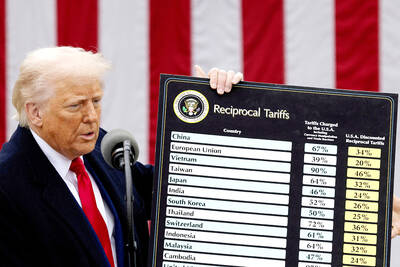The Philippine and US militaries yesterday began three weeks of joint exercises that are to simulate a “full-scale battle scenario,” as the two allies seek to deter Beijing’s ambitions in the disputed South China Sea.
As many as 17,000 personnel are expected to take part in the annual “Balikatan,” or “shoulder to shoulder” drills, which for the first time is to include an integrated air and missile defense simulation, to be attended by Philippine President Ferdinand Marcos Jr.
Sophisticated US weapons, including the NMESIS anti-ship missile system, is also to be deployed, including near a crucial chokepoint in the waters separating the northern Philippines from Taiwan.

Photo: EPA-EFE
“We will demonstrate not just our will to uphold our mutual defense treaty in existence since 1951, but our matchless capability to do so,” US Marine Corps Lieutenant General James Glynn said at the opening ceremony in Manila.
“Nothing builds bonds more quickly than shared adversity,” he said, without specifying a common threat.
Philippine Major General Francisco Lorenzo added that the 40th Balikatan exercises would reinforce the country’s ability to address “contemporary security challenges.”
The Philippines has been engaged in months of confrontations with Beijing over disputed areas of the South China Sea. It has steadily deepened defense cooperation with treaty ally the US since Marcos took office in 2022 and began pushing back on China’s sweeping claims to the crucial waterway.
In response to the drills, Beijing accused Manila of “collusion with countries outside the region.”
The exercises “undermine regional strategic stability,” Chinese Ministry of Foreign Affairs spokesman Guo Jiakun (郭嘉昆) said.
“This has already aroused strong aversion and opposition from regional countries,” he said.
Last year’s Balikatan featured tests of the US Typhon mid-range missile system.
The Philippine army subsequently said it was planning to acquire the Typhon, sparking warnings from China of a regional “arms race.”
Glynn yesterday said the Typhon system would again be present, along with the Marine Air Defense Integrated System, or MADIS, a short-range platform specializing in knocking out drones.
Besides the US, countries including Australia and Japan are sending smaller contingents to Balikatan.

Rainfall is expected to become more widespread and persistent across central and southern Taiwan over the next few days, with the effects of the weather patterns becoming most prominent between last night and tomorrow, the Central Weather Administration (CWA) said yesterday. Independent meteorologist Daniel Wu (吳德榮) said that based on the latest forecast models of the combination of a low-pressure system and southwesterly winds, rainfall and flooding are expected to continue in central and southern Taiwan from today to Sunday. The CWA also warned of flash floods, thunder and lightning, and strong gusts in these areas, as well as landslides and fallen

WAITING GAME: The US has so far only offered a ‘best rate tariff,’ which officials assume is about 15 percent, the same as Japan, a person familiar with the matter said Taiwan and the US have completed “technical consultations” regarding tariffs and a finalized rate is expected to be released soon, Executive Yuan spokeswoman Michelle Lee (李慧芝) told a news conference yesterday, as a 90-day pause on US President Donald Trump’s “reciprocal” tariffs is set to expire today. The two countries have reached a “certain degree of consensus” on issues such as tariffs, nontariff trade barriers, trade facilitation, supply chain resilience and economic security, Lee said. They also discussed opportunities for cooperation, investment and procurement, she said. A joint statement is still being negotiated and would be released once the US government has made

SOUTH CHINA SEA? The Philippine president spoke of adding more classrooms and power plants, while skipping tensions with China over disputed areas Philippine President Ferdinand Marcos Jr yesterday blasted “useless and crumbling” flood control projects in a state of the nation address that focused on domestic issues after a months-long feud with his vice president. Addressing a joint session of congress after days of rain that left at least 31 dead, Marcos repeated his recent warning that the nation faced a climate change-driven “new normal,” while pledging to investigate publicly funded projects that had failed. “Let’s not pretend, the people know that these projects can breed corruption. Kickbacks ... for the boys,” he said, citing houses that were “swept away” by the floods. “Someone has

‘CRUDE’: The potential countermeasure is in response to South Africa renaming Taiwan’s representative offices and the insistence that it move out of Pretoria Taiwan is considering banning exports of semiconductors to South Africa after the latter unilaterally downgraded and changed the names of Taiwan’s two representative offices, the Ministry of Foreign Affairs (MOFA) said yesterday. On Monday last week, the South African Department of International Relations and Cooperation unilaterally released a statement saying that, as of April 1, the Taipei Liaison Offices in Pretoria and Cape Town had been renamed the “Taipei Commercial Office in Johannesburg” and the “Taipei Commercial Office in Cape Town.” Citing UN General Assembly Resolution 2758, it said that South Africa “recognizes the People’s Republic of China (PRC) as the sole